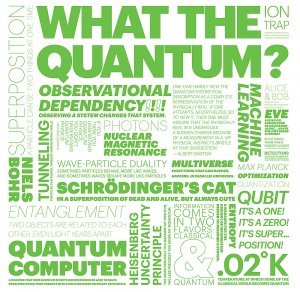In quantum physics the way in which an object or particle is observed can fundamentally change what that object or particle is. It’s a tough concept for most people to wrap their head around.
It also sounds like a pretty good game.
This week, a team of collaborators released an update to qCraft, a Minecraft mod and curriculum that hopes to teach middle school students some of the core principles of this cutting edge science.
In one of the lessons in the curriculum, for example, players have to find a bridge over an impossibly deep chasm. The only way to find it is to view the canyon from the correct angle — or to understand the idea of “observational dependency.”
“That is a real principle of quantum mechanics. In the game, it felt very fun and no one was thinking, ‘Oh my God, this is too hard,’” Katya Hott, a learning content producer at E-Line Media, said.
QCraft is the result of a collaboration between Google, E-Line Media, Teacher Gaming and the Institute for Quantum Information and Matter at Caltech, but according to E-Line’s General Manager Brian Alspach, the genesis of the project came from Google’s interest in STEM education.
“Today’s young people – kids who are at the middle school age – are going to be the generation of folks who are going to have to engage with the next generation of transformative technology that comes out there and certainly quantum computing … is one of those areas and one that they [Google] have focused on,” he said.
Listen to the full conversation here:
Creating the Game
The team knew they wanted to break down the ideas behind quantum mechanics to make them more understandable to younger students.
The first step of the project came when they considered how best to do it.
“If you wanted to introduce kids to some of the core concepts in an area like quantum mechanics why not meet them at the place where they are already at? … Minecraft as a commercial game is already hugely popular with kids in that middle school age group,” Alspach said.
According to Teacher Gaming’s Joel Levin, who blogs and tweets as the Minecraft Teacher, the next part of the process was deciding what exactly they wanted the students to take away from the game.
“We did not want the math and the hard physics involved to be the end goal,” Levin said. “What we did want is for them to have an intuitive understanding of observational dependency, of superposition, of entanglement so that if they were to encounter these words or concepts later in life, you know, they have a gut feeling for how it works.”
So the team of designers began working with CalTech and Google to develop those three core ideas of quantum physics into Minecraft game elements.
Rather than try to explain them, you may want to see what it looks like in the game through this video:
She pointed out that the team worked with teachers to ensure the game and lessons would fit into the classroom. For example, the teachers told them that individual sessions of the game should not require more than 30 minutes to finish so they could fit into a class period.
Additionally, the team built versions that were single player as well as multiplayer.
“We decided for our curriculum to have a multi-player experience because what we are often finding with MinecraftEdu in the classroom is that one of the joys of teaching with Minecraft is having all of your students in the same server at once playing together,” she explained.
Taking Advantage of the Gaming World
But how scary does it sound to teach an 11-year-old this high-level science?
Quantum mechanics is pretty heavy stuff. On qCraft’s blog, MIT’s Neil Gershenfeld described it as, “Quantum mechanics is not just difficult to learn, it literally doesn’t make sense. Our brains and language did not evolve to describe phenomena on that scale; classical intuition has no place in explaining superposition and entanglement.”
Hott agreed that the initial reaction is some hesitation, with teachers and students expressing concern about a subject that seems so technical.
But, she added, the team has built curriculum and tools to recognize that, “We do not expect the teacher to be a quantum physicist. We don’t expect them to have a ton of prior knowledge about quantum mechanics.”
That is where the fact that this is a game kicks in, they said. Players are used to the ideas of the world being different than our own in a game. Gravity may not be there. The sky might change colors.
“For a gamer, it is sometimes a very, very short distance between saying, ‘This is hard.’ And then saying, ‘This is fun,’” Levin said, adding that, “I think in traditional schools, students often don’t get past, ‘This is hard.’”
So the team hopes this gaming universe of Mincraft will allow students and regular gamers alike to dabble in some quantum mechanics and their plan is to reach out to both groups to make sure they know about it.
Alspach said the project has outreach plans that include both reaching the diverse Minecraft gamer community directly and a separate strategy around reaching teachers.
The collaborators hope to see significant use of the mod in the coming months and have aggressive targets when it comes to how many schools and installations of the game they hope to see.
For Levin, success is more specific.
“I’m going to measure impact by the effect we have on individual kids. Twenty years from now I’d love to meet and shake hands with somebody who is building a quantum computer and they say, ‘You worked on that qCraft project? That was the first time I heard about quantum physics,” he said.

